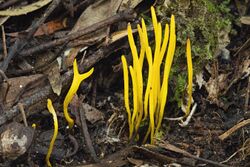Biology:Clavulinopsis amoena
| Clavulinopsis amoena | |
|---|---|

| |
| Scientific classification | |
| Domain: | Eukaryota |
| Kingdom: | Fungi |
| Division: | Basidiomycota |
| Class: | Agaricomycetes |
| Order: | Agaricales |
| Family: | Clavariaceae |
| Genus: | Clavulinopsis |
| Species: | C. amoena
|
| Binomial name | |
| Clavulinopsis amoena (Zollinger & Moritzi) Corner (1950)
| |
| Synonyms | |
| |
Clavulinopsis amoena is a clavarioid fungus in the family Clavariaceae. It forms slender, cylindrical, golden-yellow fruiting bodies that grow on the ground among plant litter. It was originally described from Indonesia and appears to be distributed in temperate areas of the southern hemisphere.
Taxonomy
The species was originally described from Java in 1844 by Swiss mycologists Heinrich Zollinger and Alexander Moritzi.
In his influential monograph of the clavarioid fungi, English mycologist E.J.H. Corner considered Clavulinopsis amoena to be a globose-spored species of variable colour and form that was widespread in the tropics, particularly in Asia.[1] American mycologist Ronald H. Petersen initially agreed with Corner that C. amoena was a globose-spored species.[2] But Petersen's subsequent study of the type specimen showed that C. amoena had ellipsoid (not globose) spores and was therefore not the same taxon described in earlier works.[3] Petersen considered Clavaria aurantia (described from Australia) and C. luteotenerrima (described from Indonesia) to be synonyms.[3]
Despite this, the name C. amoena has continued to be used for a globose-spored species in some more recent taxonomic accounts.[4][5]
Description
The fruit body of Clavulinopsis amoena is cylindrical, up to 50 by 2 mm, bright apricot yellow to cadmium yellow, borne on a similarly coloured, cylindrical stipe up to 15 by 1.5 mm. Microscopically, the basidiospores are smooth, hyaline, and ellipsoid, 6 to 7 by 4 to 4.5 µm.[3][6]
Distribution and habitat
Confusion over the identification of Clavulinopsis amoena means that its distribution is unclear. The species was initially described from Indonesia, but has also been reported from Australia and New Zealand.[3] Petersen considered that "the taxon seems to be distributed over the Southern Hemisphere, at least in temperate areas."[6] Records of C. amoena from Brazil refer to a different, globose-spored species,[4] as do at least some records from elsewhere in America.[7]
The species typically occurs in small clusters on the ground in broadleaf woodland.
References
- ↑ Corner EJH. (1950). A monograph of Clavaria and allied genera. Annals of Botany Memoirs. 1. Oxford, UK: Oxford University Press. pp. 623–4.
- ↑ Petersen RH (1979). "Notes on clavarioid fungi XVII: Clavulinopsis taxa in southeastern Australia". Sydowia 32: 209–223. https://www.zobodat.at/pdf/Sydowia_32_0209-0223.pdf.
- ↑ 3.0 3.1 3.2 3.3 Petersen RH (1980). "Type studies in the Clavariaceae vI: Four pivotal types from the Pacific tropics". Mycotaxon 12: 281–286.
- ↑ 4.0 4.1 "New species and new records of Clavariaceae (Agaricales) from Brazil". Phytotaxa 253. doi:10.11646/phytotaxa.253.1.1.
- ↑ "Taxonomy and phylogenetic relationships of Clavulinopsis (Clavariaceae, Agaricales): Description of six new species and one newly recorded species from China". Journal of Fungi 9. 2023. doi:10.3390/jof9060656.
- ↑ 6.0 6.1 Petersen RH (1988). "The clavarioid fungi of New Zealand". New Zealand Department of Scientific and Industrial Research, Bulletin 236: 1–170.
- ↑ Corner EJH (1970). Supplement to 'A monograph of Clavaria and allied genera'. Beihefte zur Nova Hedwigia. 33. Lehre, Germany: J. Cramer. p. 10.
Wikidata ☰ Q5129576 entry
 |

